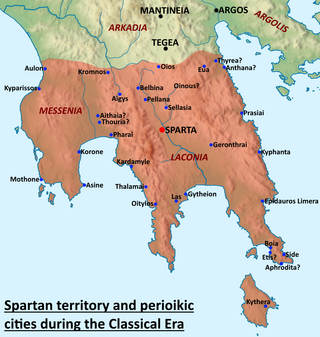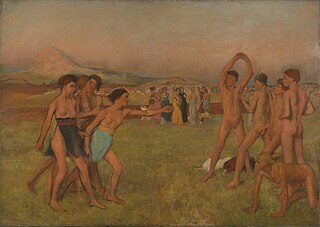Related Research Articles
Agesilaus II was king of Sparta from c. 400 to c. 360 BC. Generally considered the most important king in the history of Sparta, Agesilaus was the main actor during the period of Spartan hegemony that followed the Peloponnesian War. Although brave in combat, Agesilaus lacked the diplomatic skills to preserve Sparta's position, especially against the rising power of Thebes, which reduced Sparta to a secondary power after its victory at Leuctra in 371 BC.

Sparta was a prominent city-state in Laconia in ancient Greece. In antiquity, the city-state was known as Lacedaemon, while the name Sparta referred to its main settlement on the banks of the Eurotas River in the Eurotas valley of Laconia, in south-eastern Peloponnese. Around 650 BC, it rose to become the dominant military land-power in ancient Greece.

Leonidas I was king of the Ancient Greek city-state of Sparta. He was the son of king Anaxandridas II and the 17th king of the Agiad dynasty, a Spartan royal house which claimed descent from the mythical demigod Heracles. Leonidas I ascended to the throne in c. 489 BC, succeeding his half-brother king Cleomenes I. He ruled jointly along with king Leotychidas until his death in 480 BC, when he was succeeded by his son, Pleistarchus.
The helots were a subjugated population that constituted a majority of the population of Laconia and Messenia – the territories ruled by Sparta. There has been controversy since antiquity as to their exact characteristics, such as whether they constituted an Ancient Greek tribe, a social class, or both. For example, Critias described helots as "slaves to the utmost", whereas according to Pollux, they occupied a status "between free men and slaves". Tied to the land, they primarily worked in agriculture as a majority and economically supported the Spartan citizens.

Cleomenes III was one of the two kings of Sparta from 235 to 222 BC. He was a member of the Agiad dynasty and succeeded his father, Leonidas II. He is known for his attempts to reform the Spartan state.
Gylippus was a Spartan general (strategos) of the 5th century BC; he was the son of Cleandridas, who was the adviser of King Pleistoanax and had been expelled from Sparta for accepting Athenian bribes in 446 BC and fled to Thurii, a pan-Hellenic colony then being founded in the instep of Italy with Athenian help and participation. His mother may have been a helot, which meant he was not a true Spartiate but a mothax, a man of inferior status. Despite this, from an early childhood he was trained for war in the traditional Spartan fashion and on reaching maturity had been elected to a military mess, his dues contributed by a wealthier Spartiate patron. For an individual of marginal origins, war was an opportunity to gain honor and eminence.

Cynisca was a wealthy Spartan princess. She is famous for being the first woman to win at the Olympic Games; her horse teams competed in the sport of chariot racing, driven by male charioteers. Cynisca first entered the Olympics in 396 BC, where she won first prize competing with a team of horses she had trained herself. In 392 BC, Cynisca entered her horses in the Olympics for a second time and was awarded another victory in the same event.

The agoge was the training program pre-requisite for Spartiate (citizen) status. Spartiate-class boys entered it age seven, and aged out at 30. It was considered violent by the standards of the day, and was sometimes fatal.

Laconophilia is love or admiration of Sparta and of the Spartan culture or constitution. The term derives from Laconia, the part of the Peloponnesus where the Spartans lived.
Black soup was a regional cuisine of ancient Sparta, made with boiled pork meat and blood, using only salt and vinegar to flavour. The soup was well known during antiquity in the Greek world, but no original recipe of the dish survives today. The earliest recorded mention of the soup can be dated to the fifth century BC, in a comedy titled The Miners, written by Pherecrates. The ancient sources provide contradictory accounts on whether the soup was a luxurious meal served only at banquets or a dish that could be afforded by all Spartiates. Throughout history, black soup has been praised by and associated with figures such as Benjamin Rush and Adolf Hitler, although Hitler was (debatably) vegetarian.
Xenelasia was the practice in ancient Doric Crete and Lacedæmonia of expelling foreigners deemed injurious to the public welfare. The isolationist customs of Sparta may also sometimes be referred to as xenelasia. The majority of ancient Greek authors attribute the codification of this practice to Lycurgus.

The Perioeci or Perioikoi were the second-tier citizens of the polis of Sparta until c. 200 BC. They lived in several dozen cities within Spartan territories, which were dependent on Sparta. The perioeci only had political rights in their own city, while the course of the Spartan state exclusively belonged to Spartan citizens, or Spartiates.
Callicratidas was a Spartan navarch during the Peloponnesian War. He belonged to the mothax class so he was not a Spartiate, despite his status he had risen to prominence. In 406 BC, he was sent to the Aegean to take command of the Spartan fleet from the navarch Lysander.
A Spartiate or Homoios was an elite full-citizen male of the ancient Greek city-state of Sparta. Spartiate-class males were a small minority: estimates are that they made up between 1/10 and 1/32 of the population, with the proportion decreasing over time; the vast majority of the people of Sparta were helots (slaves).
The Arcadian League was a league of city-states in ancient Greece. It combined the various cities of Arcadia, in the Peloponnese, into a single state. The league was founded in 370 BC, taking advantage of the decreased power of Sparta, which had previously dominated and controlled Arcadia. Mantinea, a city that had suffered under Spartan dominance, was particularly prominent in pushing for its founding. The league was responsible for the foundation of Megalopolis.

The Spartan army was the principle ground force of Sparta. It stood at the center of the Spartan state, consisting of citizens trained in the disciplines and honor of a warrior society. Subjected to military drills since early manhood, the Spartans became one of the most feared and formidable military forces in the Greek world, attaining legendary status in their wars against Persia. At the height of Sparta's power – between the 6th and 4th centuries BC – other Greeks commonly accepted that "one Spartan was worth several men of any other state."

Classical Greece was a period of around 200 years in Ancient Greece, marked by much of the eastern Aegean and northern regions of Greek culture gaining increased autonomy from the Persian Empire; the peak flourishing of democratic Athens; the First and Second Peloponnesian Wars; the Spartan and then Theban hegemonies; and the expansion of Macedonia under Philip II. Much of the early defining mathematics, science, artistic thought, theatre, literature, philosophy, and politics of Western civilization derives from this period of Greek history, which had a powerful influence on the later Roman Empire. Part of the broader era of classical antiquity, the classical Greek era ended after Philip II's unification of most of the Greek world against the common enemy of the Persian Empire, which was conquered within 13 years during the wars of Alexander the Great, Philip's son.
The Spartan Constitution are the government and laws of the classical Greek city-state of Sparta. All classical Greek city-states had a politeia; the politeia of Sparta however, was noted by many classical authors for its unique features, which supported a rigidly layered social system and a strong hoplite army.
Spartan women were famous in ancient Greece for seemingly having more freedom than women elsewhere in the Greek world. To contemporaries outside of Sparta, Spartan women had a reputation for promiscuity and controlling their husbands. Spartan women could legally own and inherit property, and they were usually better educated than their Athenian counterparts. The surviving written sources are limited and largely from a non-Spartan viewpoint. Anton Powell wrote that to say the written sources are "'not without problems'... as an understatement would be hard to beat".
Two land reforms were attempted at ancient Sparta in the 3rd century BC.
References
- Hodkinson, Stephen. Property and Wealth in Classical Sparta (The Classical Press of Wales, 2000) ISBN 0-7156-3040-7
- Pomeroy, Sarah B., et al. Ancient Greece. New York, New York: Oxford UP, Inc, 1999. 483.